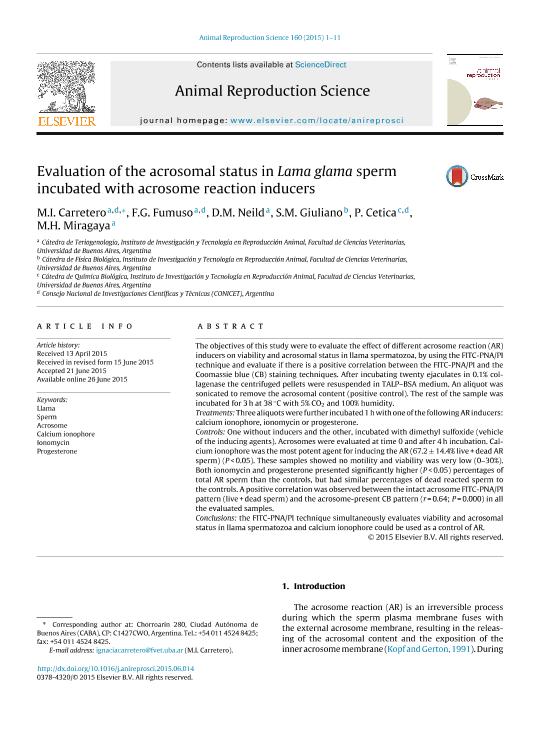Mostrar el registro sencillo del ítem
dc.contributor.author
Carretero, Maria Ignacia

dc.contributor.author
Fumuso, Fernanda Gabriela

dc.contributor.author
Neild, Debora Margarita

dc.contributor.author
Giuliano, Susana María

dc.contributor.author
Cetica, Pablo Daniel

dc.contributor.author
Miragaya, Marcelo

dc.date.available
2018-05-08T14:32:43Z
dc.date.issued
2015-09
dc.identifier.citation
Carretero, Maria Ignacia; Fumuso, Fernanda Gabriela; Neild, Debora Margarita; Giuliano, Susana María; Cetica, Pablo Daniel; et al.; Evaluation of the acrosomal status in Lama glama sperm incubated with acrosome reaction inducers; Elsevier Science; Animal Reproduction Science; 160; 9-2015; 1-11
dc.identifier.issn
0378-4320
dc.identifier.uri
http://hdl.handle.net/11336/44394
dc.description.abstract
The objectives of this study were to evaluate the effect of different acrosome reaction (AR) inducers on viability and acrosomal status in llama spermatozoa, by using the FITC-PNA/PI technique and evaluate if there is a positive correlation between the FITC-PNA/PI and the Coomassie blue (CB) staining techniques. After incubating twenty ejaculates in 0.1% collagenase the centrifuged pellets were resuspended in TALP-BSA medium. An aliquot was sonicated to remove the acrosomal content (positive control). The rest of the sample was incubated for 3h at 38 °C with 5% CO2 and 100% humidity. TREATMENTS: Three aliquots were further incubated 1h with one of the following AR inducers: calcium ionophore, ionomycin or progesterone. CONTROLS: One without inducers and the other, incubated with dimethyl sulfoxide (vehicle of the inducing agents). Acrosomes were evaluated at time 0 and after 4h incubation. Calcium ionophore was the most potent agent for inducing the AR (67.2 ± 14.4% live+dead AR sperm) (P < 0.05). These samples showed no motility and viability was very low (0-30%). Both ionomycin and progesterone presented significantly higher (P < 0.05) percentages of total AR sperm than the controls, but had similar percentages of dead reacted sperm to the controls. A positive correlation was observed between the intact acrosome FITC-PNA/PI pattern (live+dead sperm) and the acrosome-present CB pattern (r = 0.64; P = 0.000) in all the evaluated samples. CONCLUSIONS: The FITC-PNA/PI technique simultaneously evaluates viability and acrosomal status in llama spermatozoa and calcium ionophore could be used as a control of AR.
dc.format
application/pdf
dc.language.iso
eng
dc.publisher
Elsevier Science

dc.rights
info:eu-repo/semantics/openAccess
dc.rights.uri
https://creativecommons.org/licenses/by-nc-nd/2.5/ar/
dc.subject
Llama
dc.subject
Sperm
dc.subject
Acrosome
dc.subject
Calcium Ionophore
dc.subject
Ionomycin
dc.subject
Progesterone
dc.subject.classification
Otras Ciencias Veterinarias

dc.subject.classification
Ciencias Veterinarias

dc.subject.classification
CIENCIAS AGRÍCOLAS

dc.title
Evaluation of the acrosomal status in Lama glama sperm incubated with acrosome reaction inducers
dc.type
info:eu-repo/semantics/article
dc.type
info:ar-repo/semantics/artículo
dc.type
info:eu-repo/semantics/publishedVersion
dc.date.updated
2018-04-27T20:02:10Z
dc.identifier.eissn
1873-2232
dc.journal.volume
160
dc.journal.pagination
1-11
dc.journal.pais
Países Bajos

dc.journal.ciudad
Amsterdam
dc.description.fil
Fil: Carretero, Maria Ignacia. Consejo Nacional de Investigaciones Científicas y Técnicas; Argentina. Universidad de Buenos Aires. Facultad de Ciencias Veterinarias. Instituto de Investigacion y Tecnología en Reproducción Animal; Argentina
dc.description.fil
Fil: Fumuso, Fernanda Gabriela. Consejo Nacional de Investigaciones Científicas y Técnicas; Argentina. Universidad de Buenos Aires. Facultad de Ciencias Veterinarias. Instituto de Investigacion y Tecnología en Reproducción Animal; Argentina
dc.description.fil
Fil: Neild, Debora Margarita. Universidad de Buenos Aires. Facultad de Ciencias Veterinarias. Instituto de Investigacion y Tecnología en Reproducción Animal; Argentina. Consejo Nacional de Investigaciones Científicas y Técnicas; Argentina
dc.description.fil
Fil: Giuliano, Susana María. Universidad de Buenos Aires. Facultad de Ciencias Veterinarias. Instituto de Investigacion y Tecnología en Reproducción Animal; Argentina
dc.description.fil
Fil: Cetica, Pablo Daniel. Consejo Nacional de Investigaciones Científicas y Técnicas; Argentina. Universidad de Buenos Aires. Facultad de Ciencias Veterinarias. Instituto de Investigacion y Tecnología en Reproducción Animal; Argentina
dc.description.fil
Fil: Miragaya, Marcelo. Universidad de Buenos Aires. Facultad de Ciencias Veterinarias. Instituto de Investigacion y Tecnología en Reproducción Animal; Argentina
dc.journal.title
Animal Reproduction Science

dc.relation.alternativeid
info:eu-repo/semantics/altIdentifier/doi/https://doi.org/10.1016/j.anireprosci.2015.06.014
dc.relation.alternativeid
info:eu-repo/semantics/altIdentifier/url/https://www.sciencedirect.com/science/article/pii/S0378432015001451
Archivos asociados
